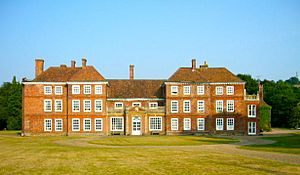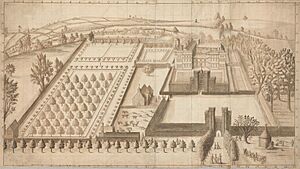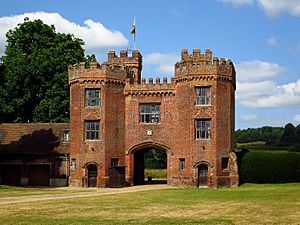Lullingstone Castle facts for kids
Quick facts for kids Lullingstone Castle |
|
|---|---|

Lullingstone Castle (the main house)
|
|
| Type | Manor house |
| Location | Lullingstone, Kent |
| Built | 1543-1580 |
| Built for | Sir Percyvall Hart |
| Rebuilt | 18th century |
| Architectural style(s) | Tudor and Queen Anne |
| Owner | Hart-Dyke family |
| Website | lullingstonecastle.co.uk |
|
Listed Building – Grade II*
|
|
| Official name: Lullingstone Castle | |
| Designated | 1 August 1952 |
| Reference no. | 1222202 |
|
Listed Building – Grade I
|
|
| Official name: The Gatehouse to Lullingstone Castle | |
| Designated | 1 June 1967 |
| Reference no. | 1217173 |
| Official name: Lullingstone Castle | |
| Designated | 18 March 2004 |
| Reference no. | 1001687 |
| Lua error in Module:Location_map at line 420: attempt to index field 'wikibase' (a nil value). | |
Lullingstone Castle is a very old and beautiful house in the village of Lullingstone, Kent, England. It's not really a castle with big walls, but a grand country home. For over 600 years, members of the Hart Dyke family have lived here. The current owner, Tom Hart Dyke, is the 20th generation of his family to call Lullingstone home.
Contents
A Look Back: Lullingstone Castle's Story
Lullingstone Castle has a long and interesting past. It was first mentioned in a very old book called the Domesday Book in 1086. This book listed all the lands in England.
Early Owners and Royal Visitors
In 1279, a man named Gregory de Rokesley bought the land. He was an important person who served as the Lord Mayor of London eight times! The land stayed in his family for many years. Later, it was sold to the Peche family.
Sir John Peche started building the current main house in 1497. He was a powerful figure in Kent. Even famous royals like King Henry VIII and his wife Anne Boleyn often visited the house. Imagine them walking through the same rooms you can see today!
From Harts to Dykes: Family History
In 1543, the estate became part of the Hart family through marriage. Sir Percyvall Hart was a key helper to several kings and queens, including Henry VIII and Elizabeth I. When he passed away in 1580, his grandson, Sir Percival Hart, took over. In 1603, Sir Percival even sent fresh fish and birds from Lullingstone to King James!
Later, another Percival Hart inherited the house. He was the High Sheriff of Kent in 1706. He made many changes to the house and gave it the name "Lullingstone Castle." His daughter, Anne, married into the Dyke family, which is how the Hart Dyke family came to own the estate.
Modern Times and New Uses
In 1934, the estate was sold to a brewery, and then to Kent County Council in 1938. During World War II, the Army used the castle. In the 1960s, a golf course and a public park were created on the grounds. Even with these changes, the main house has always stayed with the Hart Dyke family.
You might have even seen Lullingstone Castle on TV! In 2011, it was used as a filming location for a funny advert featuring meerkats.
Castle Buildings: What to See
Lullingstone Castle has some interesting buildings, including its old gatehouse and the main house itself.
The Gatehouse: A Grand Entrance
Long ago, the castle had two gatehouses. One was an outer gatehouse, which you can still see today. The other, an inner gatehouse, was taken down in the 1700s. The outer gatehouse was built in the late 1500s. It might be one of the first buildings in England made completely of brick! It is a very important historical building.
The Main House: A Mix of Styles
The main house, now called Lullingstone Castle, was built between 1543 and 1580 by Sir Percyvall Hart. It is made of red brick and has three floors. You can still see parts of the original 1500s building on the north and east sides. The front entrance was changed in the 1700s, giving it a different look.
The Beautiful Estate and Gardens
The castle is surrounded by a large park that is about 120 acres. This area used to be a deer park where people hunted. The River Darent flows through the grounds. Hidden in the park are an old bathhouse and an icehouse from the 1700s. Most of the old estate is now Lullingstone Country Park, which is open to the public.
Ancient Trees and Historic Sites
The park is home to some of the oldest oak trees in Britain. You can also find beautiful wildflowers there. There's a church called St Botolph's nearby, which is very old, possibly from Norman times. The estate also once had a Roman villa, showing how long people have lived in this area.
Silk and Unique Plants
A fascinating part of Lullingstone's history involves silk! Zoe Dyke started the Lullingstone Silk Farm here. Queen Mary visited the farm, and its silk was even used for the coronation robe of King George VI. The farm later moved, but it continued to make silk for other important royal events, like the wedding dresses of Princess Elizabeth (who became Queen Elizabeth II) and Lady Diana Spencer.
The walled garden at Lullingstone was once a herb garden. Now, it's been transformed into the amazing World Garden of Plants by the current owner, Tom Hart Dyke. Tom is a plant hunter who travels the world to find rare and interesting plants. His work on the garden was even featured in a BBC2 TV series called Save Lullingstone Castle. The garden and castle are open for visitors from April to September each year.
Images for kids
-
View inside Lullingstone Country Park
-
Wire baobab tree at World Garden of Plants
See also
 In Spanish: Lullingstone Castle para niños
In Spanish: Lullingstone Castle para niños









